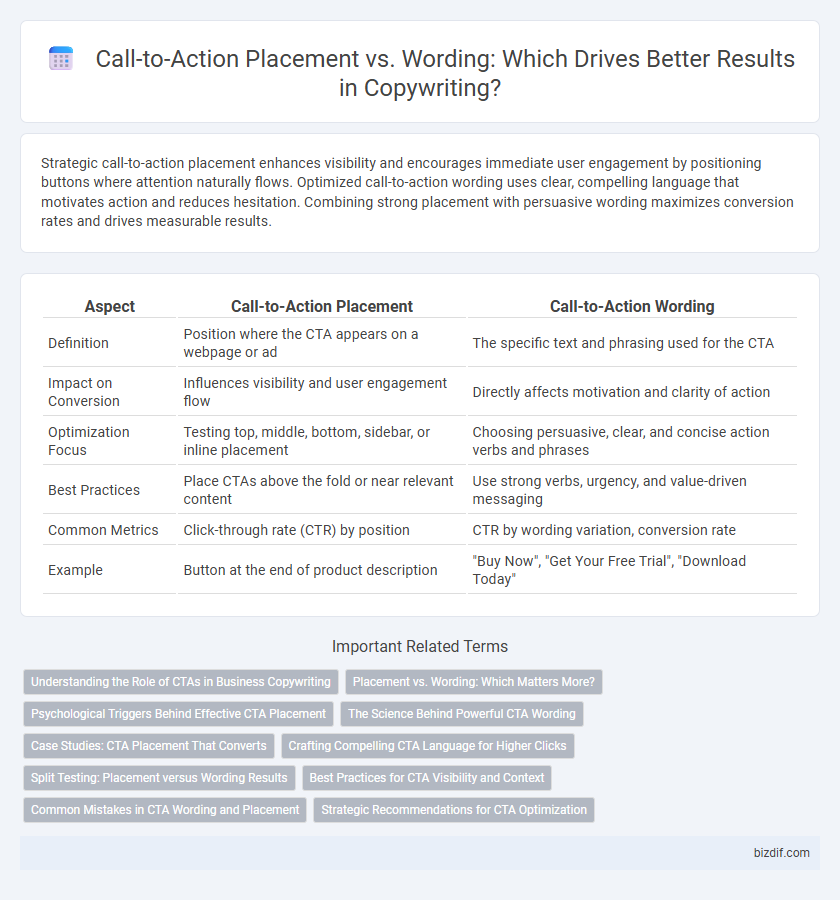Strategic call-to-action placement enhances visibility and encourages immediate user engagement by positioning buttons where attention naturally flows. Optimized call-to-action wording uses clear, compelling language that motivates action and reduces hesitation. Combining strong placement with persuasive wording maximizes conversion rates and drives measurable results.
Table of Comparison
| Aspect | Call-to-Action Placement | Call-to-Action Wording |
|---|---|---|
| Definition | Position where the CTA appears on a webpage or ad | The specific text and phrasing used for the CTA |
| Impact on Conversion | Influences visibility and user engagement flow | Directly affects motivation and clarity of action |
| Optimization Focus | Testing top, middle, bottom, sidebar, or inline placement | Choosing persuasive, clear, and concise action verbs and phrases |
| Best Practices | Place CTAs above the fold or near relevant content | Use strong verbs, urgency, and value-driven messaging |
| Common Metrics | Click-through rate (CTR) by position | CTR by wording variation, conversion rate |
| Example | Button at the end of product description | "Buy Now", "Get Your Free Trial", "Download Today" |
Understanding the Role of CTAs in Business Copywriting
Effective call-to-action (CTA) placement directly influences user engagement by guiding readers toward desired actions at strategic points within business copy, enhancing conversion rates. Equally important, precise CTA wording uses compelling language that resonates with the target audience, driving emotional responses and clear intentions. Understanding the synergy between CTA placement and wording enables businesses to optimize marketing messages, boost click-through rates, and ultimately increase sales performance.
Placement vs. Wording: Which Matters More?
Call-to-action (CTA) placement significantly influences conversion rates by ensuring visibility at critical decision points within the content, directly impacting user engagement. While compelling CTA wording enhances motivation, poorly placed CTAs often go unnoticed, reducing effectiveness regardless of phrasing quality. Optimal results arise from strategically positioned CTAs paired with persuasive wording tailored to the target audience's intent and behavior.
Psychological Triggers Behind Effective CTA Placement
Effective Call-to-Action (CTA) placement leverages psychological triggers such as the F-shaped reading pattern, ensuring CTAs appear where users' eyes naturally focus. Positioning CTAs near compelling content or decision-driving information enhances urgency and relevance, increasing conversion rates. Strategic placement also taps into cognitive biases like the Von Restorff effect, making the CTA stand out visually and mentally for greater impact.
The Science Behind Powerful CTA Wording
Powerful CTA wording leverages psychological triggers such as urgency, clarity, and emotional appeal to drive user engagement and conversions. Research shows that action-oriented verbs combined with personalized language significantly increase click-through rates compared to generic phrases. Strategic placement enhances visibility, but scientifically optimized wording directly influences the user's decision-making process by aligning with cognitive biases and motivation factors.
Case Studies: CTA Placement That Converts
Case studies reveal that strategic call-to-action placement significantly boosts conversion rates, often outperforming even the most compelling CTA wording. Placing CTAs above the fold or near engaging content guides user attention effectively, increasing click-through by up to 35%. Data-driven insights underscore that context-aware placement tailored to user behavior enhances CTA visibility and response more than creative phrasing alone.
Crafting Compelling CTA Language for Higher Clicks
Strategically positioning call-to-action buttons enhances visibility, but compelling CTA wording drives engagement by using action-oriented verbs and clear benefits. Phrases like "Get Your Free Trial Now" or "Unlock Exclusive Discounts Today" increase urgency and click-through rates by appealing directly to user intent. Optimizing both placement and language ensures a seamless path from interest to conversion in digital marketing campaigns.
Split Testing: Placement versus Wording Results
Split testing reveals that call-to-action (CTA) placement often impacts conversion rates more significantly than CTA wording, with buttons placed above the fold typically generating higher engagement. However, optimized wording tailored to target audience behavior enhances clarity and urgency, which can amplify the effect of strategic placement. Combining data-driven insights on both placement and wording yields the most effective CTA performance improvements in copywriting campaigns.
Best Practices for CTA Visibility and Context
Effective call-to-action placement dramatically improves visibility by positioning buttons where users naturally focus, such as above the fold or near engaging content. Complementing placement, carefully crafted CTA wording enhances context relevance, using action-oriented language that aligns with user intent and drives higher click-through rates. Combining strategic placement with persuasive, clear wording ensures optimal engagement and conversion performance on digital platforms.
Common Mistakes in CTA Wording and Placement
Common mistakes in call-to-action (CTA) wording include using vague phrases like "Click here" or overly complex language that confuses users, reducing conversion rates. Poor CTA placement often involves positioning buttons below the fold or amid cluttered content, leading to decreased visibility and engagement. Optimizing both wording and strategic placement ensures higher click-through rates and improved user interaction.
Strategic Recommendations for CTA Optimization
Effective Call-to-Action (CTA) optimization hinges on strategic placement and compelling wording that drives conversions. Position CTAs prominently within the user's natural reading flow, such as near engaging content or at decision points, to increase visibility and interaction rates. Employ clear, action-oriented language tailored to the target audience's intent, emphasizing urgency or value to maximize click-through and conversion performance.
Call-to-Action Placement vs Call-to-Action Wording Infographic

 bizdif.com
bizdif.com